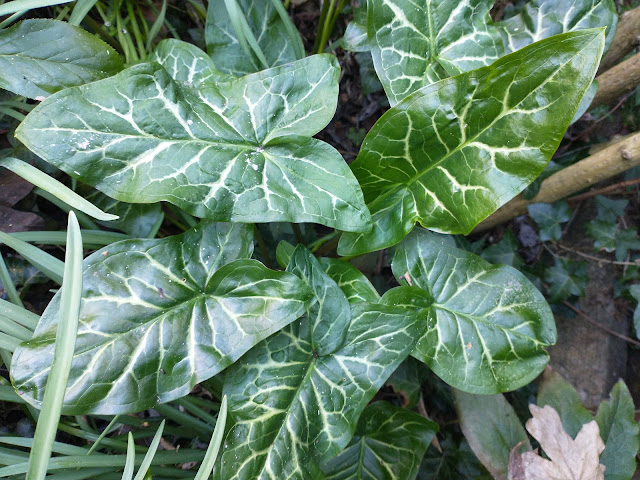Sometimes 'wrong place' can be right
I've seen quite a lot of online chat about this striking plant lately. Firstly asking for an ID - it's Arum italicum subsp. italicum 'Marmoratum' by the way - quite a mouthful, eh? With the ID duly confirmed, the conversation then turns to its renowned thugish qualities, with many a resolution made for it to never darken the commenter's garden ever again.
I can offer an alternative viewpoint. It's never been a problem here at VP Gardens. Its marbled foliage brightens many a winter's walk here and then it quietly starts to fade away into summer oblivion around about now.
I reckon the key to my success and higher regard is I've planted it in the wrong place. The commenters' dire warnings centre around the plant's spathe replete with tempting red berries poised ready for the birds to eat and distribute its seeds elsewhere. Mine has never done that and a quick check of the plant's requirements shows its preference for sand or loam soils. Mine is planted in deep clay and it seems that's enough to tame it into a leaves only plant which makes it garden worthy in my eyes.
The same can't be said for its wild cousin Arum maculatum* which has spread itself from the public open space next door into the heart of my garden. Clay doesn't seem to deter it, though it does have a marked preference for the gravelly parts of the garden where it pops up incessantly. I'm currently immersed in daily patrols to find and dig out this particular garden visitor with care. It's not enough just to dig up the leaves; if one small piece of its tuber left behind, it's sufficient for it to restart its attempt at world dominance.
It seems sometimes the 'right plant, right place' mantra can be relaxed a little for those plants with a robust nature, and a 'wrong place' chosen instead. It just needs the right choice of variety or cultivar for it to work.
Do you have any examples of plants in the wrong place that work for you?
* = you may know this plant as Lords-and-ladies or Cuckoo pint












I've heard that Japanese anemone can take over a garden bed, but I haven't had that problem with the one I planted in my back garden
ReplyDeleteI've found the same as you Margaret. When I wrote about Japanese anemones many moons ago I didn't know about their renowned thuggish qualities until I read my Comments. Mine are very well behaved here and like the Arum, I think it's the clay soil that's held them back.
Delete